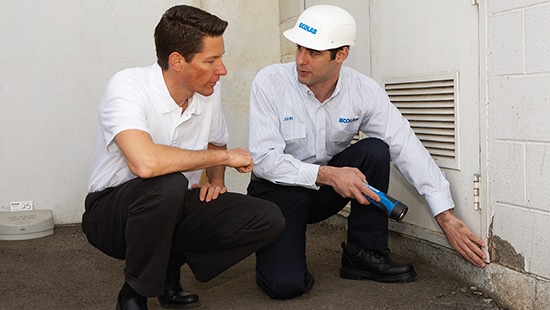Exclusion: A Cornerstone of Integrated Pest Management (IPM)
Pest Press Newsletter

Flies are not the only pest that are of increased concern during the summer months. The warming weather brings a vast array of insects, rodents, birds, and other wildlife out of their winter harboring and into the environs of commercial properties across the continent. While many of these are outdoor-living creatures, few will hesitate to venture indoors when the opportunity and attraction exists. Unfortunately, that opportunity can be as minute as a gap in the foundation, a hole in a screen, or a door that stayed open a little too long. The attraction may be food smells emanating out a vent, a space deemed ideal for nesting and breeding, or simply harborage on an inclement day.
It is for all such reasons that exclusion (i.e., keeping pests out) is important to a successful pest management program. It is so important in fact, that in 2012, a consortium of industry, agency, and academic professionals formed the Scientific Coalition on Pest Exclusion (SCOPE) to study and provide guidance on exclusion measures as a cornerstone of integrated pest management (IPM). As stated in its philosophy, “Pest exclusion that prevents vermin from entering the indoor environment is an ancient concept. It represents a proactive measure that serves as the first line of defense against pests.”
This issue’s cover story included prevention solutions for flies based on three key areas: the exterior, entry points, and the interior. Following is more detail on the first two of these which are the primary focal points of exclusion:
The Exterior. Keeping pests away from your facility reduces the number that may try to enter.
- Garbage. Food scraps, organic waste, and other typical garbage of commercial facilities is a primary pest attractant. Keeping the area clean and bins lidded reduces the feeding and breeding attraction.
- Standing water. In addition to providing an ideal breeding ground for mosquitoes, rodents, wildlife, and even certain ant species, they will see areas around standing water as ideal nesting sites.
- Clutter. Similarly, insects, rodents, and wildlife love clutter for its harborage potential. Clutter on the property provides shelter in close proximity to your facility.
- Vegetation. Excessive vegetation can provide similar harborage, and any shrubbery, branches, or vines that contact the building helps give pests a “bridge” for potential entry.
Entry Points. Keeping pests from entering reduces the need for interior control and elimination.
- Gaps and cracks. Insects, rodents, and many wildlife can wriggle through gaps much smaller than one would expect. Thus, inspecting for and sealing all structural cracks, gaps, and holes is essential to blocking pest entry.
- Screens. In a similar way, window and door screens that aren’t well fitted, have holes, or are of a mesh size greater than 20x20 can allow small insects to fly or climb through. It also can be beneficial to screen vents, roof caps, and other such openings to keep wildlife from entering.
- Doors. Just as doors provide access for people, they can provide access for pests, particularly when left or held open. Self-closing doors can help alleviate this; air or strip doors on dock or delivery doors can enable supply access while providing pest protection; and positive pressure in vestibules relative to the outdoors will deter pests from attempting to enter with your guests.
- Employee practices. Perhaps most critical of all is educating employees on keeping doors closed. A common issue among commercial facilities of all types is the propping of doors during break times. Because employee doors often open into alleys or other less maintained back-of-facility areas, propped doors are open invitations to pests. (Need better compliance from your employees? See this Quick Tip.)
In addition to keeping out summer pests, implementing exclusion now enables the facility to prepare for fall and winter pests before inclement weather sets in and makes outdoor work less conducive or desirable.


